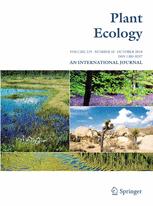Ver ítem
- xmlui.general.dspace_homeCentros Regionales y EEAsCentro Regional Entre RíosEEA ParanáArtículos científicosxmlui.ArtifactBrowser.ItemViewer.trail
- Inicio
- Centros Regionales y EEAs
- Centro Regional Entre Ríos
- EEA Paraná
- Artículos científicos
- Ver ítem
Artificial perches promote vegetation restoration
Resumen
Native ecosystems are continuously being transformed mostly into agricultural lands. Simultaneously, a large proportion of fields are abandoned after some years of use. Without any intervention, altered landscapes usually show a slow reversion to native ecosystems, or to novel ecosystems. One of the main barriers to vegetation regeneration is poor propagule supply. Many restoration programs have already implemented the use of artificial perches in order
[ver mas...]
Native ecosystems are continuously being transformed mostly into agricultural lands. Simultaneously, a large proportion of fields are abandoned after some years of use. Without any intervention, altered landscapes usually show a slow reversion to native ecosystems, or to novel ecosystems. One of the main barriers to vegetation regeneration is poor propagule supply. Many restoration programs have already implemented the use of artificial perches in order to increase seed availability in open areas where bird dispersal is limited by the lack of trees. To evaluate the effectiveness of this practice, we performed a series of meta-analyses comparing the use of artificial perches versus control sites without perches. We found that setting-up artificial perches increases the abundance and richness of seeds that arrive in altered areas surrounding native ecosystems. Moreover, density of seedlings is also higher in open areas with artificial perches than in control sites without perches. Taken together, our results support the use of artificial perches to overcome the problem of poor seed availability in degraded fields, promoting and/or accelerating the restoration of vegetation in concordance with the surrounding landscape.
[Cerrar]

Autor
Guidetti, Brenda Yamile;
Amico, Guillermo Cesar;
Dardanelli, Sebastian;
Rodriguez Cabal, Mariano Alberto;
Fuente
Plant ecology 217 (7) : 935–942. July 2016
Fecha
2016-07
Editorial
Springer
ISSN
1385-0237
1573-5052 (Online)
1573-5052 (Online)
Formato
pdf
Tipo de documento
artículo
Palabras Claves
Derechos de acceso
Restringido
 Excepto donde se diga explicitamente, este item se publica bajo la siguiente descripción: Creative Commons Attribution-NonCommercial-ShareAlike 2.5 Unported (CC BY-NC-SA 2.5)
Excepto donde se diga explicitamente, este item se publica bajo la siguiente descripción: Creative Commons Attribution-NonCommercial-ShareAlike 2.5 Unported (CC BY-NC-SA 2.5)

